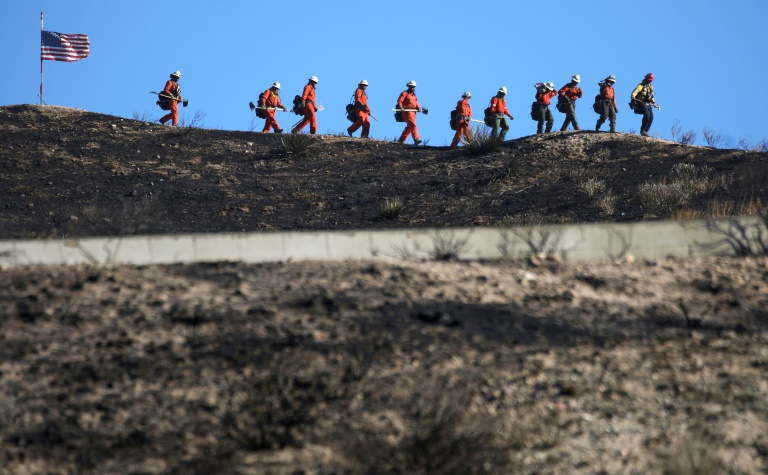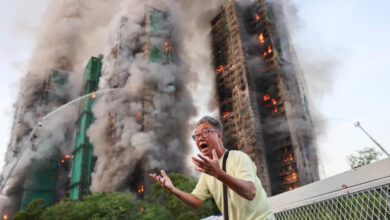
Wildfires raged across California on Friday, destroying homes and forcing evacuations, as over 1,000 firefighters tackled flames in the southern part of the state alone.
Tens of thousands of residents near Santa Clarita, north of Los Angeles, fled their homes as the so-called Tick Fire scorched over 4,000 acres (1,618 hectares) and was only ten percent contained by Friday evening.
The blaze forced the shutdown of all schools in the area as well as a major freeway, creating a traffic nightmare for commuters.
New evacuations in the area were ordered early Friday as the fire that began the day before continued to spread, driven by so-called Santa Ana winds gusting up to 65 miles (105 kilometers) per hour.
Some 1,325 firefighters backed by air tankers and helicopters were battling the flames that raced toward densely packed communities and threatened 10,000 structures, officials said.
Six homes were destroyed, Los Angeles County Fire Chief Daryl Osby told a news conference, adding that the number was expected to rise.
At least four other fires have erupted in southern California this week, fueled by high temperatures in the 80s and 90s (above 30 Celsius) and bone dry conditions.
A red flag warning indicating ripe conditions for wildfire was in effect for more than 18 million people in the southern part of the state until Friday evening.
The National Weather Service warned that although wind speeds were set to decrease later Friday, they were expected to pick up again on Sunday and Monday in the southern part of the state.
“It looks like another Santa Ana is coming,” meteorologist Eric Boldt told AFP. “Right now, we’re looking at moderate strength winds (Sunday and Monday).”
Still, he added, the state remains “critically dry” with little humidity, creating an environment ripe for large and dangerous fire growth.
– ‘Story about greed’ –
A number of wildfires are also raging in the northern part of the state. The most serious — the Kincade Fire — broke out late Wednesday in the Sonoma wine region, also prompting evacuations.
The high risk of fires has led to pre-emptive power cuts to thousands of customers and prompted Governor Gavin Newsom to declare a state of emergency in Sonoma and Los Angeles counties.
Newsom traveled to Sonoma on Friday to survey areas impacted by the Kincade Fire which has grown to around 23,700 acres and was only five percent contained as of Friday evening.
The blaze, which is burning in remote steep terrain, has destroyed nearly 50 structures and forced the evacuation of the entire community of Geyserville and nearby vineyards.
Newsom told reporters the area looked like a “war zone,” with homes and vehicles destroyed.
Residents said they barely had time to gather their belongings as the ferocious fire approached their homes.
“We looked up the hill and couldn’t believe what we saw,” ranch owner Dwight Monson, 68, told the Los Angeles Times, saying the fire moved 14 miles in five hours before destroying four homes and a barn on his property.
The state’s largest utility, Pacific Gas & Electric Co., warned that millions of people in northern and central parts of the state could have their power cut off during the weekend given the high risk of fire.
The company has come under intense scrutiny after it reported Thursday that even though power to nearly 28,000 customers in Sonoma County had been shut down on Wednesday, some of the high-voltage transmission lines were still operating when the fire broke out.
The same type of equipment was responsible for the state’s deadliest wildfire ever — the Camp Fire in 2018 which killed 86 people.
PG&E, which filed for bankruptcy earlier this year, has been blamed for several other fires in the state in recent years.
Newsom hit out at the company on Friday, saying it had put “profits over the people of California for too long.”
The governor said it was “infuriating beyond words” that a state as innovative as California has to see these types of blackouts, adding that the frequency of fires could not only be blamed on climate change.
“It’s about dog eat dog capitalism meeting climate change,” he said, referring to PG&E. “It’s a story about greed and they need to be held accountable.”
Instense fires also erupted over the border in Mexico’s Baja California state, where local civil protection authorities said on Friday that three people had been killed and over 150 homes destroyed.
The director of Civil Protection, Antonio Rosquillas, explained that the municipality of Tecate, bordering the United States, was worst hit.
Image: GETTY IMAGES NORTH AMERICA/AFP / MARIO TAMA Tens of thousands of residents in southern California fled their homes as the so-called Tick Fire scorched over 4,000 acres (1,618 hectares)




